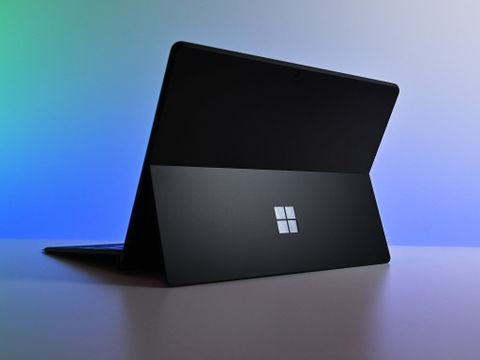The Microsoft Surface Pro X is the first stab at the new Windows 10 on ARM platform. While Microsoft has done Windows ARM devices before (see Surface RT), this time the company is offering a more satisfying vision.
So, is the Surface Pro X a hit or a miss? Like all things, there is nuance. Built for "tech-forward mobile workers," the Pro X is undoubtedly divisive. For the right audience, the Pro X will be everything they need in modern portable PC. For most, they are better served with Surface Pro 7.
All-day battery, a slick new design, a super clever pen that hides away, large display, and always-connected 4G LTE make Surface Pro X a class all its own. But do you need one or just want one?
I've spent the last ten days with the Surface Pro X. Here is what I like, what needs work, who should not buy it, and why I actually prefer the Surface Pro X overall.
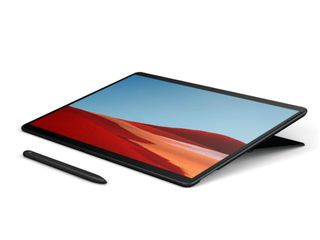
From $999Bottom line: The Surface Pro X will be the perfect laptop for some users, but many will be better served with a Surface Pro 7. The Microsoft SQ1 ARM-based processor and GPU is faster than expected — rivaling a Core i5. The nuance around what apps work and the lack of gaming will be off-putting for some buyers, but paired with the right owner the Surface Pro X is an exciting evolution of modern computing worth considering.
For
- Outstanding hardware design
- Unlocked 4G LTE SIM + eSIM
- Upgradable SSD
- Ten-hour battery life (ARM64)
- Slim Pen and keyboard are super clever
- Excellent audio, display, and typing
Against
- ARM64 is confusing
- Bad for gaming
- No Dolby Vision or anti-glare display
- Seven-hour battery life (x86)
So slick, so modern
Microsoft Surface Pro X design and features

The Surface Pro X is possibly one of the most beautiful looking computers of 2019, up there with the Dell XPS 13 2-in-1. With razor-thin bezels — at least on the sides — slightly curved aluminum body, and a 13-inch display, the Surface Pro X makes up for the Surface Pro 7's re-used looks. It's safe to assume that Microsoft didn't tinker with the Surface Pro 7 this year to give the Surface Pro X some wow factor, and it works.
Surface Pro X is a unique device with a particular target audience. Think of it more like a specialized tool rather than a do-it-all PC.
Surface Pro X only comes in one color — black. It's professional-looking, but the lack of zest for flair is depressing. The metal chassis is also exceptionally prone to fingerprints, something that the platinum Surface Pro 7 is adept at avoiding. Tossing on a custom skin from dbrand may not be a bad choice.
At just 7.3mm thin, the Surface Pro X feels very much like an iPad Pro — solid, metal, premium, and lean. The Surface Pro 7, by comparison, is a hair thicker at 8.5mm. Weight, however, is similar between both devices at just 1.7 pounds (775 grams).
| Category | Surface Pro X |
|---|---|
| Operating System | Windows 10 Home |
| Display | 13-inch PixelSense, 3:2 aspect ratio, 2880x1920 (267 PPI) |
| Processor | Microsoft SQ1 |
| GPU | Adreno 685 |
| Memory | 8GB or 16GB LPDDR4x |
| Storage | 128GB, 256GB, or 512GB |
| Rear Camera | 11MP autofocus (1080p) |
| Front Camera | 5MP (1080p) |
| Security | Windows Hello face authentication camera |
| Connectivity | Wi-Fi 5 Qualcomm Snapdragon X24 Bluetooth 5.0 |
| Ports | 2x USB 3.2 Gen 2 Type-C, 1x nano SIM, 1x Surface Connect, Surface Keyboard connector |
| Battery | Up to 13 hours typical use |
| Dimensions | 11.3 x 8.2 x 0.28 inches (287mm x 208mm x 7.3mm) |
| Weight | 1.7 lbs (774g) |
| Colors | Black |
Audio is excellent, thanks to the dual front-facing speakers. They're loud and vibrant and are remarkably similar to the Apple iPad and iPhone sound profile.
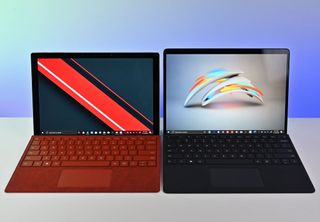
There are two types of keyboards for the Surface Pro X, neither of which are included. The $140 Surface Pro X Keyboard is standard and comes in black while the $270 Surface Pro X Signature Keyboard with Slim Pen Bundle uses a black Alcantara fabric and includes the $145 new Surface Slim Pen.
Ports are sparse with just two USB Type-C Gen 2, either of which can be used for charging, data, or display out. Neither are Thunderbolt 3. There is no Type-A port, so users will need a dongle which is not included. While the lack of a micro SD card reader is unsurprising, the omission of a 3.5mm headphone jack is regrettable. Microsoft sells a $12 Type-C to headphone adapter for those who do not want to use Bluetooth.


While there is Wi-Fi 5 (802.11ac), the Surface Pro X, unfortunately, lacks newer Wi-Fi 6 AX. Bluetooth 5 and the 4G LTE X24 modem provide wireless connectivity. The LTE modem is a world-modem and not carrier- or SIM-locked, and users can sign up for an eSIM within Windows 10 directly. Users can even switch between a physical SIM and eSIM dynamically, which is excellent for traveling.
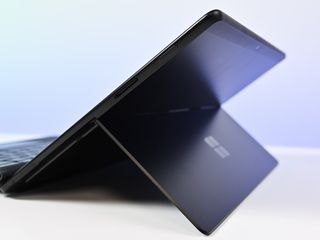
One upside of the new Surface Pro X design is modularity. Below the kickstand, there is a door that pops off using an included SIM tray tool. Below that door is the replaceable M.2 2230 NVMe SSD and nano-SIM card slot for the 4G LTE modem (eSIM is also supported). Smaller M.2 2230 drives are harder to find, but they can be bought inexpensively online, giving users an easy way to upgrade (or replace) storage. Because of this feature, the site iFixit gives the Surface Pro X a favorable rating for repairability.
Overall, the Surface Pro X feels and looks very premium. That's good considering the eye-watering $1,000 starting point.
Bright and glossy
Microsoft Surface Pro display
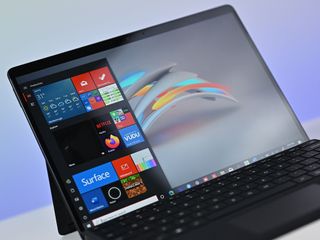
Due to the thinner side bezels, the Surface Pro X gets a larger 13-inch display compared to the 12.3-inch one found on the Surface Pro 7. That number may seem small, but it is noticeable with the Surface Pro X being more enjoyable to use.
The 2880 x 1920 resolution gives a pleasing 267 pixel-per-inch (PPI) density. It's a higher resolution than the Surface Pro 7's 2736 x 1820, but due to its smaller size results in the same 267 PPI as the Surface Pro X.
Due to driver incompatibility, I was unable to test for screen brightness and color gamut. Microsoft quotes screen brightness at 450 nits, which is higher than the 400 nits of the Surface Pro 7. That seems fair as side by side the Surface Pro X is brighter. Assuming the color gamut is like the Surface Pro 7, the Surface Pro X should give 98 percent for sRGB and 73 percent for AdobeRGB, which is above average, but not extraordinary.
The cameras on the Surface Pro X are the best of any Surface – and Windows 10 PC – to date.
Like my criticism of the Surface Pro 7 and Surface Laptop 3, the Surface Pro 7 omits wide-color gamut (WCG) abilities, high-dynamic-range (HDR)/Dolby Vision, and anti-glare that other PCs in this price category feature.
Similar to other Surface PCs, the Surface Pro X lets users switch between an "enhanced" color profile with a more saturated look and higher contrast or a more neutral sRGB mode where color correctness is necessitated.
Slimming down and hiding away
Microsoft Surface Pro X pen and inking
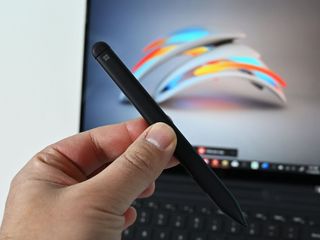
Like all Microsoft Surface PCs, there is an option for a pen. This year is a bit different, though, as Microsoft has a new Surface Slim Pen that — as the name suggests — is shaped differently. Eschewing the round traditional pen shape, the Surface Slim Pen is similar to a carpenter pencil.
That new design lets the Surface Slim Pen stow nicely in the Surface Pro X's keyboard deck. Held by strong magnets, the tray also wirelessly recharges the pen when not in use. It's a smart idea — one that lets you forget you even have a pen right up until you need it. Hidden away, it also means you'll never lose the pen in your bag. The magnets are so good that even if you place then pen down incorrectly in the tray, it flips over to make sure it charges.
Functionally, the Surface Slim Pen is the same as the regular Surface Pen. It has a Bluetooth button at one end that also double as an eraser. There are two buttons near the tip for functions that can be assigned.

Based on Microsoft Pen Protocol (MPP), formerly known as DuoSense2 under N-trig, the Surface Slim pen supports tilt and 4,096 levels of pressure sensitivity. Because of this, you can use the Surface Slim on other Surface PCs, and the older, regular Surface Pen also works on the Surface Pro X.
For artists, the usual pen jitter still occurs when slowly drawing straight lines.
Surface Pro X is not a lousy PC; it just a special one needing to find the right owner and that can be hard to figure out.
I had no issues using the Surface Slim Pen for notetaking or marking up documents. While you can use it for drawing and higher-level artistry, I think Microsoft is keener on people using this pen for work-related tasks.
Sadly, the new Surface Slim Pen is not cheap at $145. The extra $45 (compared to the regular Surface pen) likely goes towards the wireless charging technology. If you buy the Surface Slim Pen separately, you still get a small wireless charging dock for it.

Microsoft's latest Surface stylus
With the launch of the Surface Pro X, Surface Pro 7, and Surface Laptop 3, Microsoft redesigned the Surface Pen and threw in some wireless charging for good measure.
Best cameras around
Microsoft Surface Pro X keyboard and cameras
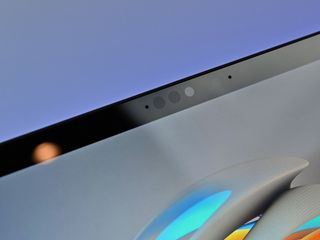
Considering the new design for the Surface Pro X, the keyboard feels remarkably familiar. With three-stage backlighting, ample key travel, and a decently sized glass-topped trackpad, the Surface Pro X's keyboard is as good as the Surface Pro 7's.
Of course, some will still have an issue with "lapability" and the Surface Pro X following similar complaints of the Surface Pro series. This model does not advance the category any further, but I'd argue the current design is nearly perfect considering the 2-in-1 design.


One small change I have not seen mentioned elsewhere are some tiny magnets that help keep the Surface Pro X Signature Keyboard closed. While you can shake it loose, the magnets help lock the cover to the Surface Pro X's display. It's a small but welcomed addition.


The cameras on the Surface Pro X are the best of any Surface — and Windows 10 PC — to date. They're terrific with excellent sharpness and clarity, beating even the Surface Pro 7. The 5MP full HD front-facing camera with dual Studio Mics ensure exceptional Skype conference calls. New in the back is an 11MP full HD (1080p) camera with autofocus. That's a small bump from the Surface Pro 7's 8MP camera, but it shows when taking pictures of whiteboards.
Windows Hello — Microsoft's system for bio-authentication and facial recognition — works quite well as anticipated. Due to the Qualcomm ARM processor, the Surface Pro X is nearly "instant on" each time you open the keyboard. That said, the Intel-based Surface Pro 7 is often faster, which is surprising.
Faster than you think
Microsoft Surface Pro X benchmarks and battery

Talking about the Surface Pro X for performance and battery is nuanced. Powered by the Microsoft SQ1 processor, which is an amped-up Qualcomm Snapdragon 8cx at 3GHz, the Surface Pro X runs Windows 10 Home with surprising speediness.
To get technical, the Surface Pro X runs an ARM64 processor, which is different from an Intel or AMD x86 one. While the Surface Pro X can run older desktop (32-bit x86) applications, it does so in an emulation layer. These apps generally run fine, albeit with a slight performance hit compared to running native ARM64 apps. Those native apps include ones recompiled for ARM64 — like the new Microsoft Edge browser — or most apps in the Microsoft Store based on UWP.
Compared to the Intel Core i5-8250U with Intel UHD 620 Surface Pro X easily topples it by a wide margin.
Microsoft claims that "95 percent" of the software people run on this class of device is covered by the Surface Pro X. The exception being 64-bit x86 applications, with the most notorious being modern Adobe software. Two qualifications though about 64-bit apps. It is rumored that Microsoft will be adding 64-bit x86 app emulation sometime in 2020 and Adobe has stated they are in the process of recompiling many of its popular apps for ARM64. That news changes nothing for the present, but the limits of Windows 10 on ARM and the Surface Pro X are resolvable.
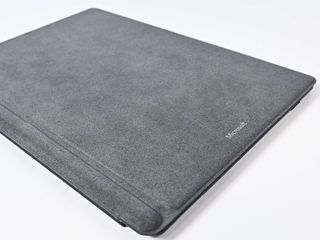
Qualcomm claimed that the Snapdragon 8cx can best an 8th Gen Intel Core i5 processor. Those claims are accurate. When running apps compiled for ARM64 or based on the Universal Windows Platform (UWP), the Surface Pro X is quite fast for this class of device.
Geekbench 5
Geekbench 5.0 (CPU) (Higher is better)
| Device | CPU | Single core | Multi core |
|---|---|---|---|
| Surface Pro X | SQ1 | 725 | 2,819 |
| Surface Laptop 3 13.5 | i5-1035G7 | 1,177 | 4,413 |
| Surface Laptop 2 | i5-8250U | 909 | 3,372 |
| Surface Pro 7 | i5-1035G4 | 1,191 | 4,441 |
| Surface Pro 6 | i7-8650U | 1,113 | 3,519 |
| Surface Pro 6 | i5-8250U | 904 | 3,440 |
| Dell XPS 13 2-in-1 7390 | i7-1065G7 | 1,209 | 3,571 |
Geekbench 4
Geekbench 4.0 (CPU) (Higher is better)
| Device | CPU | Single core | Multi core |
|---|---|---|---|
| Surface Pro X (ARM) | SQ1 | 3,505 | 11,727 |
| Surface Pro X (x86) | SQ1 | 2,182 | 6,822 |
| Samsung Galaxy Book2 (ARM) | SD850 | 2,262 | 7,405 |
| Samsung Galaxy Book2 (x86) | SD850 | 1,345 | 4,164 |
| HP Envy x2 (ARM) | SD835 | 2,111 | 6,314 |
| Surface Go | Pentium | 2,078 | 3,934 |
| Surface 3 | Atom x7 | 1,078 | 2,777 |
| Surface Laptop 3 13.5 | i5-1035G7 | 5,265 | 17,345 |
| Surface Laptop 2 | i5-8250U | 4,203 | 13,233 |
| Surface Laptop | i5-7200U | 3,725 | 7,523 |
| Surface Pro 7 | i5-1035G4 | 5,245 | 17,350 |
| Surface Pro 6 | i7-8650U | 5,037 | 13,864 |
| Surface Pro 6 | i5-8250U | 4,287 | 14,031 |
| Surface Pro 5 | i7-7660U | 4,513 | 9,346 |
| Surface Pro 5 | i5-7300U | 4,302 | 8,482 |
| Surface Pro 4 | i5-6300U | 3,319 | 6,950 |
| Dell XPS 13 2-in-1 7390 | i7-1065G7 | 5,459 | 19,097 |
3DMark
Night Raid 1.0 (Higher is better)
| Device | CPU | Score |
|---|---|---|
| Surface Pro X | Microsoft SQ1 | 7,078 |
| Lenovo | i5-8250U | 6,517 |
| Dell | i7-8650U | 6,085 |
| Samsung Galaxy Book2 | Snapdragon 850 | 2,972 |
SSD
CrystalDiskMark (Higher is better)
| Device | Read | Write |
|---|---|---|
| Surface Pro X | 2,023 MB/s | 832 MB/s |
| Samsung Galaxy Book2 | 722 MB/s | 205 MB/s |
| HP Envy x2 | 513 MB/s | 197 MB/s |
| Surface Go (SSD) | 1,185 MB/s | 133 MB/s |
| Surface Go (eMMC) | 260 MB/s | 145 MB/s |
| Surface 3 | 149 MB/s | 33 MB/s |
| Surface Laptop 3 13.5 | 2,338 MB/s | 1,583 MB/s |
| Surface Laptop 3 15 | 2,028 MB/s | 806 MB/s |
| Surface Laptop 2 | 1,509 MB/s | 811 MB/s |
| Surface Laptop | 486 MB/s | 244 MB/s |
| Surface Pro 7 | 2,040 MB/s | 809 MB/s |
| Surface Pro 6 | 1,632 MB/s | 814 MB/s |
| Surface Pro 5 | 847MB/s | 801 MB/s |
| Surface Book | 1,018 MB/s | 967 MB/s |
| Dell XPS 13 2-in-1 7390 | 2,400 MB/s | 1,228 MB/s |
.
Let's talk context using Geekbench 4. Compared to the Samsung Galaxy Book2 – another Windows 10 on ARM PC running the older Snapdragon 850 chipset — the Surface Pro X emulating Win32 almost beats that device when running native ARM64. The multi-core score with the Microsoft SQ1 processor also approaches a Core i5-8250U when running native ARM64 apps. Indeed, the octa-core SQ1 dominates the Surface Go's dual-core Pentium (11,727 vs. 3,934) and easily beats it even for single core (3,505 vs. 2,078).
The Adreno 680 GPU in the Surface Pro X is no slouch, either. When using 3DMark's GPU-intensive Night Raid 1.0 benchmark, the Surface Pro X (7,078) more than doubles the Samsung Galaxy Book2 (2,972). Compared to the Intel Core i5-8250U with Intel UHD 620 (6,517), the Surface Pro X easily topples it by a wide margin.
Thanks to added PCIe NVMe support for the SSD, even storage has jumped to 2,000/800 MB/s sequential read and write speeds on the Surface Pro X. Previous Snapdragon PCs were held back by slower eMMC storage –which limited performance to just 700/200 MB/s. Those results put the Surface Pro X's storage performance at the same level as the Surface Laptop 3 15-inch with AMD.
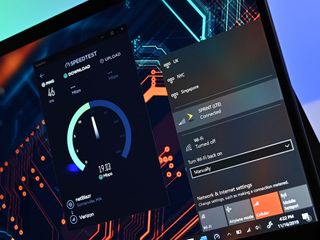
RAM is also much better too. Previously, Windows 10 on ARM PCs were mostly limited to 4GB and DDR3. The Surface Pro X not only skips that for 8GB, but there is a 16GB model too (used in this review). That RAM is the newer LPDDR4x and is quite performant and energy-efficient.
Whatever your thoughts on Windows 10 on ARM, it is clear Qualcomm is making massive generational jumps in performance.
If you need a PC with LTE, turns on quickly, and brings the benefits of a 2-in-1 laptop, Surface Pro X solves some problems for you.
Unfortunately, the promises of a "weeks' worth of battery" have evaporated as Qualcomm ramps up processor and GPU performance. Microsoft claims just 13 hours of usage from the 38WHr battery. It is fair to say that 10 hours is attainable when sticking with Microsoft Store apps (ARM64, UWP) but falls closer to 7 hours if only using emulated 32-bit x86 ones like Google's Chrome browser. Those are still good results for a PC this light and thin with LTE — it's about 25 percent more longevity than a Core i5 Surface Pro 7.
Recharging is also a highlight. Like the Surface Pro 7 and Surface Laptop 3, the Surface Pro X ships with a 65-watt Surface connect charger with Fast Charge ability. I was able to jump from 18 percent battery to 62 percent (up 44 percent) in just 30 minutes. Another 30 minutes brought the Surface Pro X to 90 percent resulting in about 70 percent charge per hour. Users can also charge with one of the two Type-C ports as an alternative.

Thermals are excellent with the Surface Pro X as the device barely ever gets warm. There is no ventilation or fans needed, so noise concerns are non-existent.
The bottom line on the Surface Pro X's performance is this: when running native ARM64 or UWP apps, it's a speedy system on par or even ahead of most 8th Gen Intel Core i5 Ultrabooks. When emulating x86 32-bit applications, performance slows closer to an Intel Core i3.
Target audience
Surface Pro X: Who is this for?
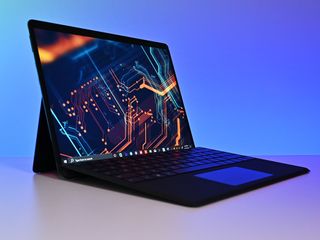
Surface Pro X is a unique device with a particular target audience. Think of it more like a specialized tool rather than a do-it-all PC.
Microsoft Surface hardware chief Panos Panay said the Surface Pro X is for "a tech-forward, mobile professional". That sounds like corporate marketing jargon, but there is some truth to it. Much of today's workforce is increasingly mobile, relying on a few core productivity-based apps like Microsoft Office, OneDrive, Outlook, web, PDF readers, remote access, VPN, and custom line-of-business (LOB) apps. These workers need something very portable, long battery life, 4G LTE, and instant-on abilities with inking for document management.
Panay says more about who would benefit from the Surface Pro X:
And so, if you're leaning into tech, and you want something a little bit cutting edge, this is a great product. It's crazy cool. If you work on a train, a bus, a plane, if you're ride-sharing in a car, you like working at the park or at Starbucks, that's a mobile user to me. They use their products everywhere. It's perfect for that.
That's a very different demographic than general computing with traditional Intel-based Ultrabooks or gaming devices. You would also be forgiven for not being a part of the target audience for the Surface Pro X, which is why the Surface Pro 7 still exists. Could you use other laptops for this scenario? Sure, but the Surface Pro X with LTE, longer battery, and always-on ability is in a class of its own.
The Pro X audience is not mainstream, but it is increasingly relevant for what is often referred to as "nomadic workers". The Economist wrote that by 2035, up to one billion workers could be classified as "location independent." Microsoft — in conjunction with Qualcomm — has been hard at work making a line of PCs that cater to this crowd.
If you need a PC that's always on LTE, turns on quickly, and brings the benefits of a 2-in-1 laptop, Surface Pro X solves some problems for you. But if you want PC gaming, the ability to run computer-aided design (CAD) apps, heavy-lifting things like video editing and media creation, then the Surface Pro X creates problems. Knowing where you fall on that spectrum determines if the Surface Pro X is right for you.
Confused? That's understandable. Luckily, Microsoft has a tool to help steer you towards the right Surface.
Tough call for buyers
Microsoft Surface Pro X buy or not?
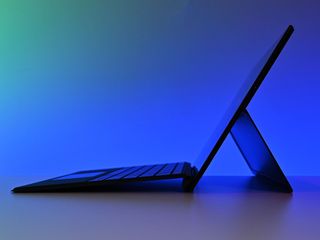
Reviews for the Surface Pro X are mixed, at best. Part of that is due to the inability to run high-level video editing applications (although VideoReDo and Avidemux work well), or professional photo apps from Adobe (Polarr Photo Editor Pro is an excellent alternative).
Is the criticism warranted? It depends on how you approach the Surface Pro X. I'd argue that many reviewers treat the Surface Pro X like any laptop. It's not. It's meant as a lightweight, always-connected, thin-client for productivity-based jobs. Writers, journalists, students, academics, "nomadic" self-starters, road-warriors, real estate workers, or anyone who wants an iPad-like experience can all benefit from Surface Pro X. I could contend these are niche users but that doesn't make them less critical. There are dozens of laptops, Ultrabooks, work stations, gaming rigs, and convertibles on the market for consumers who don't fit the Surface Pro X's demographic.
Undeniably, video games are almost all but out on the Surface Pro X save for older 32-bit games (e.g., StarCraft: Remastered), or casual ones from the Microsoft Store like Angry Birds 2. Microsoft's Project xCloud, which lets you stream console-quality games, can solve this problem, but Project xCloud for PC is not due until sometime in early 2020. You should buy a laptop on what it can do today, not what is promised tomorrow. (I have heard Project xCloud runs great on Surface Pro X).
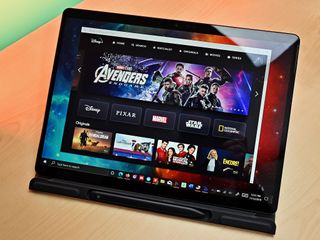
My dilemma for this review is meshing my preferences with what is best for the potential buyer. I could tell you to pass on the Surface Pro X, but that betrays the fact that for my job and lifestyle, it is the laptop I use daily. Here is a running list of apps I use on the Surface Pro X without any issues:
- Microsoft Office (Word, OneNote, Excel)
- Microsoft Edge (ARM64)
- Hulu
- Netflix
- Amazon Prime Video
- Spotify
- VUDU
- Disney+
- Microsoft Teams
- Slack
- Mail (Outlook.com)
- Flow Mail (Gmail)
- Polarr Photo Editor Pro
- Microsoft News
- GroupMe
- OneDrive
- Skype
- Microsoft To Do
- myTube! (YouTube)
- MobileDiscord PTB (Discord)
- Unigram (Telegram)
- ExpressVPN using manual configuration
There are no compromises I am making with the Surface Pro X compared to other laptops. But I do gain 4G LTE, an excellent display, satisfying audio, an all-day battery, and one of the most refreshing PCs around.
If Microsoft's new Edge browser is not your choice, Firefox now has an ARM64 version in testing and, of course, you could just run Google Chrome (albeit with a slight hit on battery and performance). Other popular apps like Apple iTunes, Amazon Music, Audible, Facebook, Sling TV, VLC, Paint.net, and others all are available too. And while the lack of gaming is noteworthy, I rely on my Nintendo Switch Lite to fulfill my mobile needs regardless of what laptop I carry anyway.
So, who should not buy Surface Pro X? People who want PC gaming, software developers, those who rely on Adobe apps, and people who do a lot of video editing. For those users, the Surface Pro 7 would be a much better choice.
While I didn't have any catastrophic bugs with the Surface Pro X, I did experience an issue with the display brightness slider not responding (fixed upon a reboot). I also find the Surface Pro X goes into a "deep sleep" state more often than the Intel-based Surface Pro 7, which was surprising — Intel is catching up to some of Qualcomm's flashiest selling points.
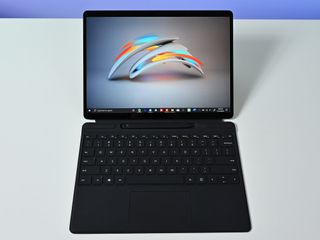
But the big question for most people is if the Surface Pro X is worth it? Probably not because most people also don't need 4G LTE and a strictly productivity-focused, mobile thin client PC. Surface Pro X is the most expensive Windows on ARM PC yet. Starting at $1,000, you also need to add at least $140 for the keyboard, or $270 if you want the keyboard and Surface Slim Pen. You could drop $2,070 (plus tax) in total for the 16GB model with 512GB of storage, keyboard, and pen. That's outlandish.
Like the new Samsung Galaxy Fold, the Surface Pro X is cutting edge, and with that comes compromises (as well as a dent in your wallet). Because of the cost and the nuance around apps and gaming, most people will be better served to buy Surface Pro 7 (or even Surface Pro 6 on discount).
But for those who need a thinner convertible PC with LTE, long battery life, inking, more modern design, and who work primarily with ARM64 or UWP apps, the Surface Pro X is worthwhile. No PC checks all of those boxes. That doesn't make the Surface Pro X a lousy PC; it just makes it a special one needing to find the right owner.
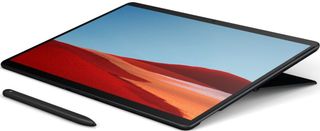
The thinnest and lightest Surface Pro available
Surface Pro X delivers the most exciting design for the Surface Pro yet. While the ARM processor is faster than expected for many casual users, a Surface Pro 7 will be a smarter buy. But for those who need a light, thin, LTE-enabled productivity laptop, the Surface Pro X offers a unique set of features not found anywhere else. It's not a bad PC; it just needs the right owner.
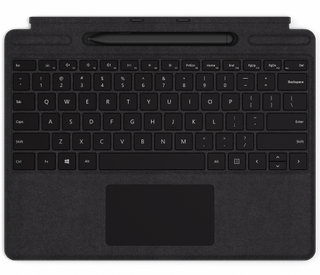
This bundle includes the Surface Pro X Signature Keyboard that features Alcantara and the Surface Slim Pen that charges wirelessly within the keyboard.

Daniel Rubino is the Editor-in-chief of Windows Central. He is also the head reviewer, podcast co-host, and analyst. He has been covering Microsoft since 2007, when this site was called WMExperts (and later Windows Phone Central). His interests include Windows, laptops, next-gen computing, and watches. He has been reviewing laptops since 2015 and is particularly fond of 2-in-1 convertibles, ARM processors, new form factors, and thin-and-light PCs. Before all this tech stuff, he worked on a Ph.D. in linguistics, watched people sleep (for medical purposes!), and ran the projectors at movie theaters because it was fun.
